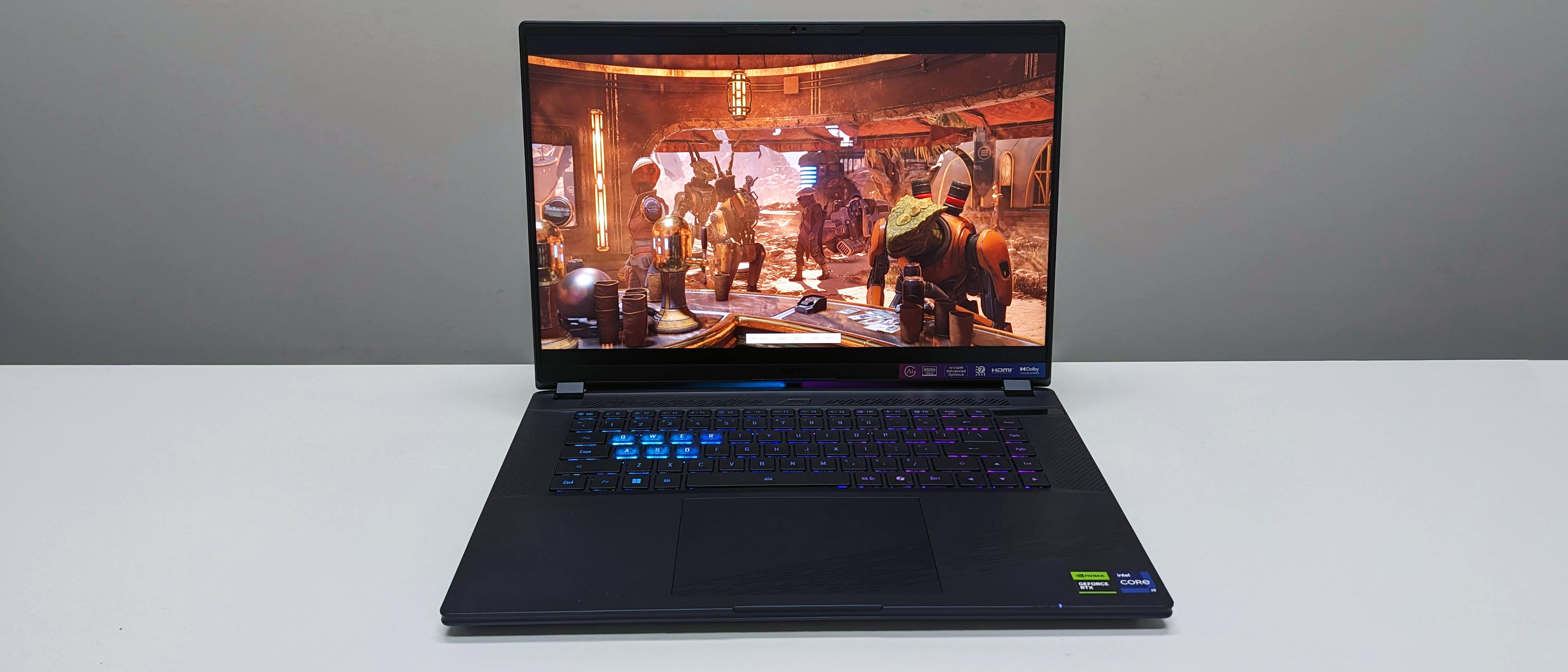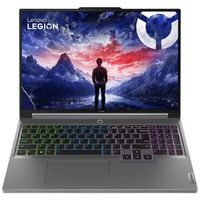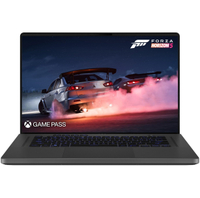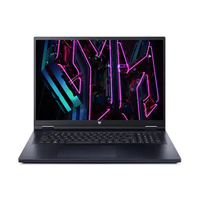TechRadar Verdict
The Aorus 16X is one of the best performing gaming laptops I have tested and it gives excellent results in both GPU- and CPU-heavy workloads. Gaming frame rates are amongst the best available for an RTX 4070 and the laptop is especially well optimized for settings best suited to the hardware. On the flip side, the 16X has some key limitations for creator use or those who value USB-C charging.
Pros
- +
Class-leading performance
- +
Great display
- +
Excellent configurations available
Cons
- -
Unpolished software
- -
Limited USB-C charging
- -
Noisy under load
Why you can trust TechRadar
Gigabyte Aorus 16X: Two-minute review
The Aorus 16X is a high-end gaming laptop aimed at those who don’t want to compromise performance and are willing to live with a larger, heavier machine. To give some perspective about the size, the 16X weighs in at 2.3kg (5.07 lb) and measures 35.6 x 25.4 x 2.7cm (14.01 x 10 x 1.06 inch). In other words, chunky yet able to be slipped into a bag without any drama – quite similar to comparable laptops from other brands. It also comes in a range of different configurations that pair up powerful Intel i7 and i9 HX series CPUs with Nvidia RTX 4000 series GPUs. There is also a larger Aorus 17X for those who prefer a bigger screen or even more powerful hardware.
The 16X I tested for this review features a mighty Intel Core i9-14900HX CPU (5.8GHz, 24 core), while graphics are provided by a GeForce RTX 4070 8GB GPU with a 140W TGP (total graphics power). The 16-inch screen has a 16:10 aspect ratio, slim borders, 2560 x 1600 resolution, a fast 165Hz G-Sync compatible refresh rate, 400-nit peak brightness, 3ms response time and covers 100% of the sRGB color space. You get dual DDR5 memory slots and, in my case, 32GB of 5600MHz RAM was installed along with two M.2 PCIe Gen4x4 NVMe SSD slots equipped with 2x 1TB drives. I appreciate that Gigabyte opted for a larger than normal 99Wh battery, and gave it the ability to fast charge to 50% in just 30 minutes.
The 16X has Intel Wi-Fi 7 (802.11be 2x2), Bluetooth 5.4 and a 1Gb LAN port on the left-hand side. The laptop features HDMI 2.1 output, a microSD card slot, a 3.5mm audio jack, and a 1080p IR webcam that is Windows Hello ready. You also get a USB-A 3.2 Gen2 port on each side, while the right has a Type-C 3.2 connection that supports Displayport 1.4, and the left has Type-C that supports Thunderbolt 4 (USB4, DisplayPort 1.4) and can charge the laptop at up to 100W.
With a 170W thermal capacity, the Aorus 16X makes sure the GPU isn’t held back by cooling. Hitting 120+ fps in demanding games, you will need the detail levels lowered if using the screen’s native res, or playing at 1080p if you want to keep the other settings maxed out. Thanks to being paired up with a powerful i9 CPU and excellent cooling system, the GPU can sustain higher frame rates in many games compared to the other laptops I am still testing (stayed tuned for those reviews). The RTX 4070 can pull up to 140W under heavy load, so chasing the highest possible frame rates is a rather hot and noisy affair. But with the Gigabyte software in control, the laptop still managed excellent frame rates at a much lower sound level.
The same is true for productivity tests, and the Aorus 16X pushes the i9-14900HX quite far before the fans become too loud. Performance is scaled back when on battery, but reasonably heavy productivity workloads and lighter gaming is possible unplugged. Thanks to the large 99Wh battery, at 50% screen brightness the 16X manages just over 8 hours of light office tasks or video playback before needing to be charged.
Many people buy a high-end laptop just to game, whereas others want it to pull double duty as a powerful workstation. While primarily a gaming machine, Gigabyte does pitch the Aorus 16X to creators who can leverage the powerful GPU and CPU for other tasks. The 16X does a great job of this when plugged into its AC adapter (or even on battery), but USB-C use (such as with a dock or charger) is very limited. This is primarily due to very heavy throttling of the CPU and GPU when USB-C charging is used, which drops performance to barely usable levels. USB-C charging is also often much slower than expected.
On the plus side, the keyboard on the 16X is excellent, with satisfying keystrokes and little bounce, while the touchpad is large and precise. The fun RGB LED backlighting can be set to show off your style or be toned down as needed. The webcam is nothing special but does work well with Windows Hello for facial recognition. The speakers are decent for a laptop and work fine for watching a movie.
Overall the Aorus 16X is a great option for those who want premium gaming performance in a mostly portable package, but unless your creator work is on your desk at home (or you don’t mind lugging the power brick around), the laptop has some key limits as a workstation.
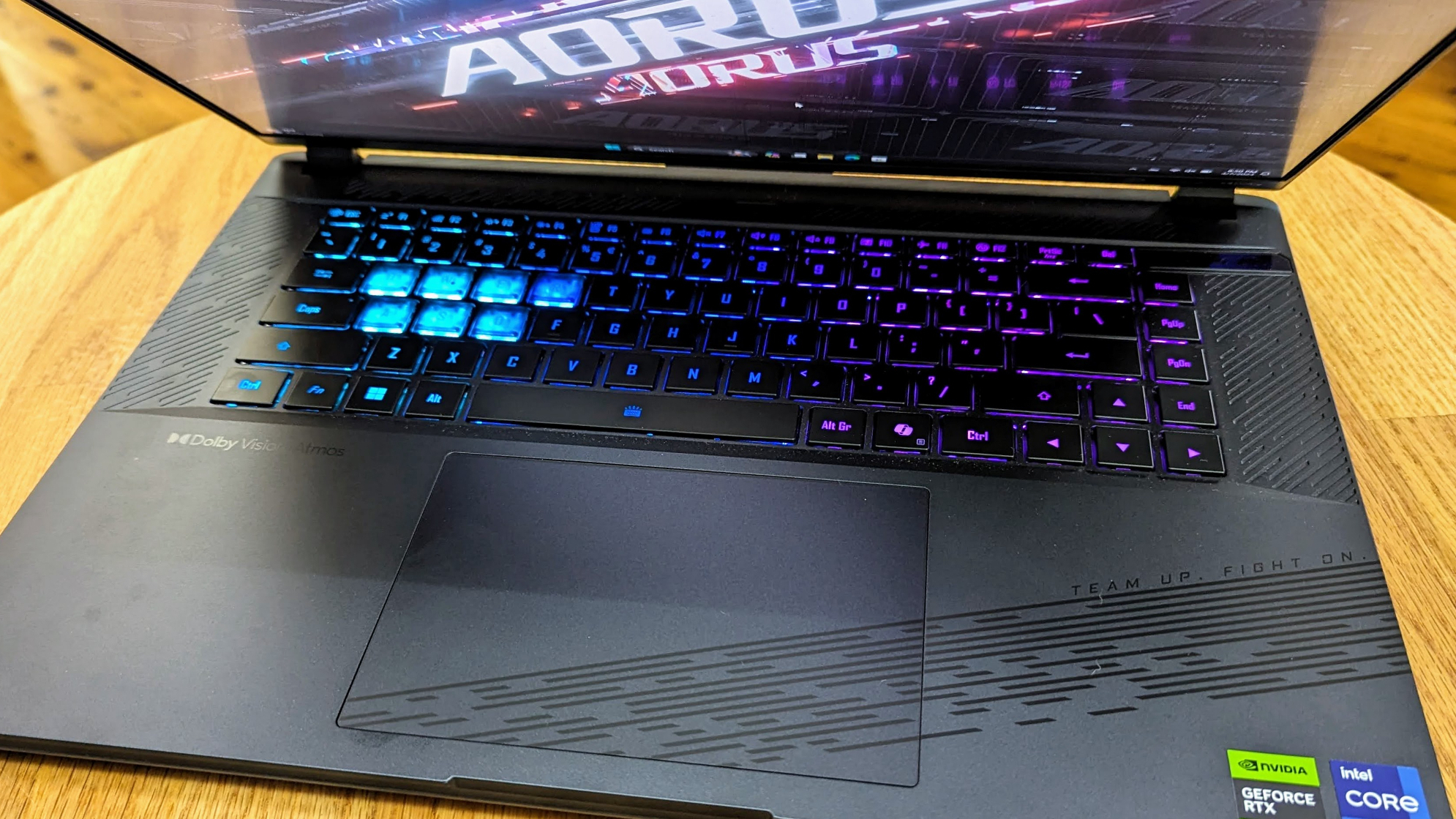
Gigabyte Aorus 16X: Price & availability
- How much does it cost? List price from $2,099 / £2,099 / AU$3,499
- When is it available? Available now
- Where is it available? Available globally
At the launch price, the Gigabyte Aorus 16X doesn’t offer standout value for a RTX 4070-powered laptop. The good news is that prices have started to drop, and larger discounts are available that are often 10% or more off the list price.
Of course, the Aorus 16X also comes in a RTX 4060 variant that starts from as little as $1,400 / £1,500 / AU$2,399 for the configuration with a i7-13650HX CPU and 16GB of RAM.
- Value score: 4 / 5
Gigabyte Aorus 16X: Specs
Availability varies widely depending on your location, but overall the 16X has a reasonable number of configurations that include the Intel i7-13650, i7-14650 and i9-14900 CPUs, paired up with the RTX 4060 or 4070 GPU, up to 64GB of RAM, and dual SSDs up to 4TB.
The specs listed below are for the 16X model tested for this review.
| Component | Gigabyte Aorus 16X |
|---|---|
| Price | $2,099 / £2,099 / AU$3,499 |
| CPU | Intel Core i9-14900HX CPU |
| GPU | Nvidia GeForce RTX 4070 8GB 140W TGP |
| Screen | 16-inch, 2560 x 1600 IPS, G-Sync, 165Hz refresh rate, 3ms GTG, 100% sRGB |
| RAM | 32GB 5600MHz DDR5 RAM (upgradable) |
| Storage | 2x 1TB NVMe SSD |
| Ports | 1x Thunderbolt 4 with DisplayPort and 100W PD charging, 1x USB-C 3.2 Gen 2 with DisplayPort, 2x USB-A 3.2, 1x HDMI 2.1, Gigabit Ethernet, microSD card reader, 3.5mm audio jack |
| Wireless | Wi-Fi 7, Bluetooth 5.4 |
| Battery | 99Wh |
| Weight | 2.3 kg (5.07 lb) |
| Dimensions | 35.4 x 24.6 x 1.62 ~ 1.72 cm (13.94" x 9.69" x 0.64" ~ 0.68") |
- Specs score: 4 / 5
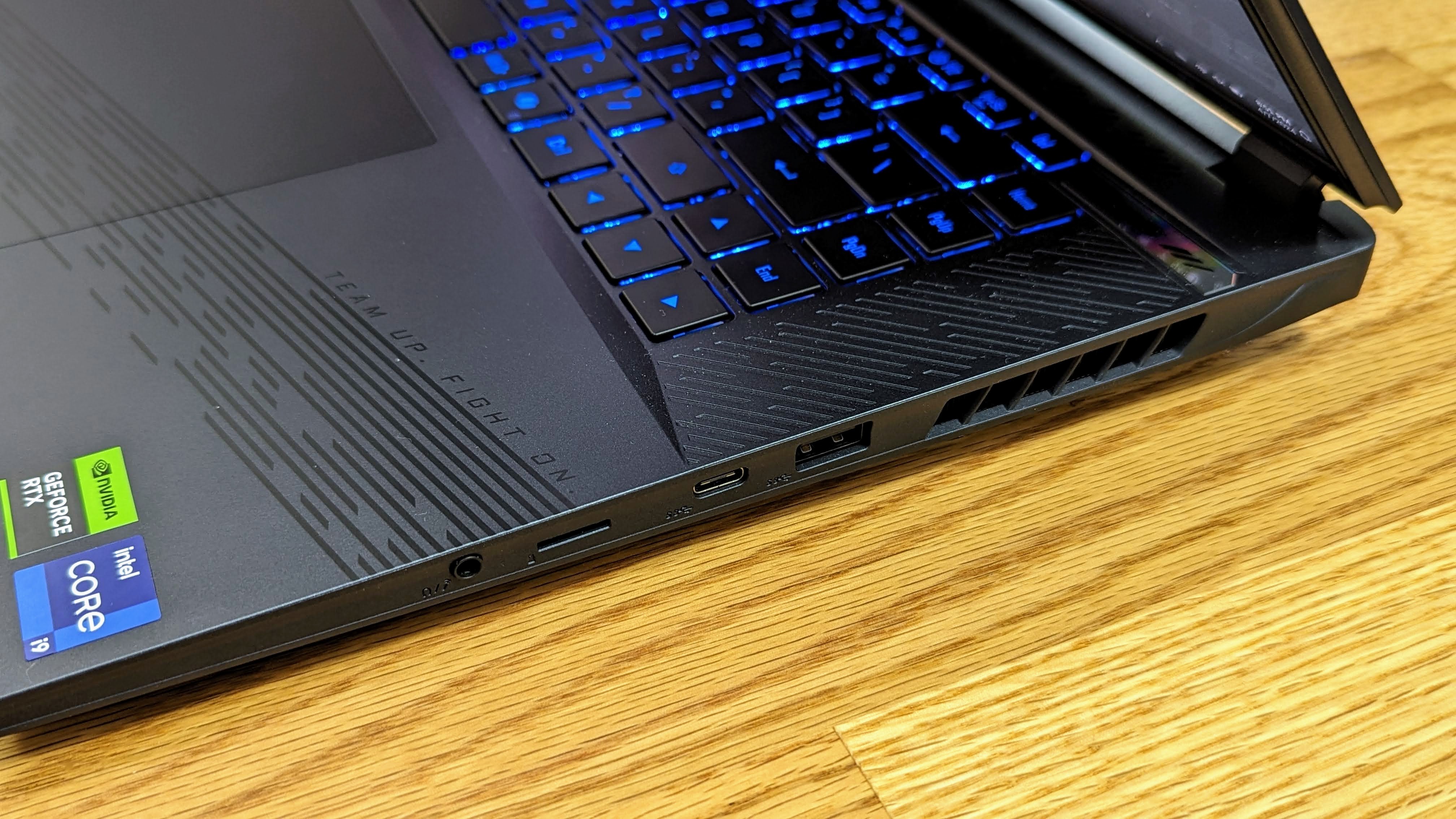
Gigabyte Aorus 16X: Design
- Very effective cooling
- Customizable lighting
- Premium features
Despite having a large 16-inch screen, the Aorus feels more compact than expected due to some important design choices such as ultra-slim bezels on the display and the 16:10 aspect ratio. The laptop has loads of great features that help make it a more premium option, such as Nvidia Advanced Optimus for easy GPU switching, G-Sync for smooth gaming, the latest Wi-Fi 7 (plus Bluetooth v5.4) and an IR webcam that supports Windows Hello for facial recognition logins.
The 16X is specced with an extra large 99Wh battery, versus the 80 or 90Wh models more commonly used in gaming laptops. The 16X has upgradeable RAM (as is normal for all but the thinnest gaming laptops), but also has dual SSD slots. While the model I tested came equipped with two drives, other configurations only have the one, leaving the second slot free for a later upgrade.
The 16X also gets gamer-focused extras, such as RGB LED lighting (including an Aorus logo projection at the rear) and clear WASD keycaps. The Aorus 16X is equipped with a better-than-average LCD screen that does 100% sRGB colors and up to 400-nit brightness. The panel's 165Hz refresh rate is also well matched to the RTX 4060 or 4070 used in the 16X.
The Windforce cooling system on the 16X is excellent at dumping heat, but I found it to be quite noisy at full tilt. Even at lower load it comes across noisier than expected if left on higher performance modes, but this more due to the software preemptively maximizing cooling, rather than actual high heat loads. The 16X can spool up the cooling fans to higher RPMs than many other gaming laptops, so after I spent a little time manually adjusting the fan profiles the noise was much reduced. Or just letting the Gigabyte software adjust works almost as well.
I found the typing experience on the Aorus 16X keyboard to be excellent – thanks in large part to the deep 1.7mm of key travel. While there is no numpad, the keyboard has an extra row on the right and better spacing on the arrow keys. The RGB LED color options are reasonably good, and the clear keycaps look great without being over the top. The trackpad is oversized and very responsive, and while it’s centrally mounted, the extra row of keys on the right of the keyboard means your hands are not aligned to the trackpad when typing. I’d have preferred to see the trackpad slightly further to the left.
The webcam quality is perfectly fine for everyday use – nothing to write home about here good or bad – and the support for Windows Hello facial recognition helped me forget about the lack of a fingerprint reader. The speakers give quite good range and bass (for a laptop anyway) and work well for watching a movie, but not everyone will be enthused by the way certain genres of music sound.
The 16X has a good selection of ports, and includes Ethernet and HDMI 2.1, plus a gaggle of high-speed USB A and C ports that include support for Displayport. Due to the cooling fan setup, the ports are located quite far forward on the sides of the laptop and can mean cables will more easily overlap into mousing space – especially for left-handers.
All in all the 16X design combines together a well-balanced set of features and hardware, without anything that is overkill, or key features that are missing.
- Design score: 4 / 5
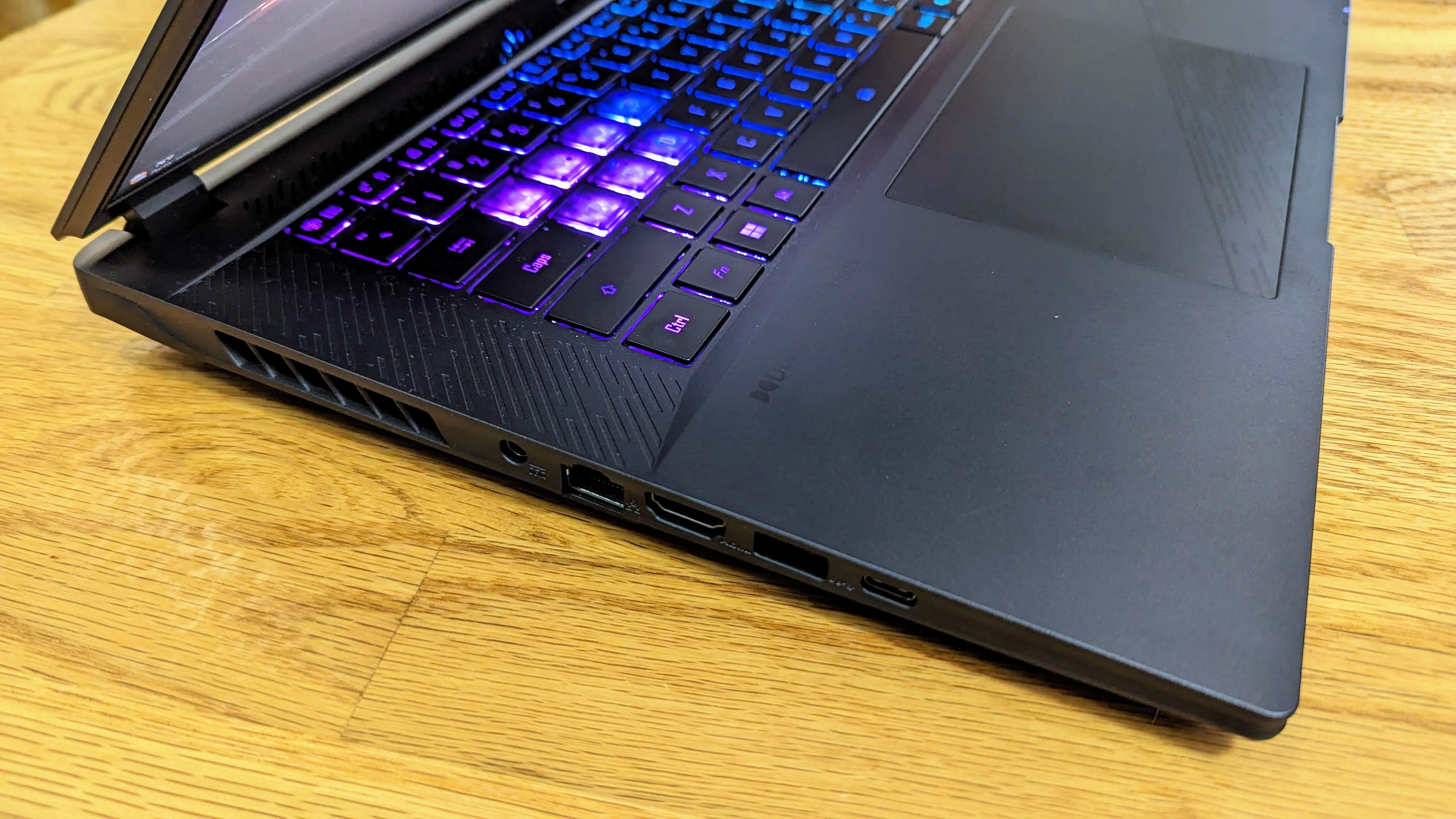
Gigabyte Aorus 16X review: Software and Features
- No third-party bloat
- Overblown AI branding
- Slightly buggy control software
The Aorus 16X is being marketed as an AI gaming laptop by Gigabyte, but it’s important to note that on the hardware side, the AI components consist of the Nvidia GPU rather than a dedicated NPU unit as featured in the new Snapdragon Elite CPUs or the Intel Core Ultra processors. That doesn’t mean the laptop is any less capable of AI tasks (in fact the opposite), but it is less efficient and currently lacks support for many new Windows CoPilot features.
Gigabyte (like many manufacturers) is all aboard the AI hype train and uses the term to describe normal everyday software (such as automatic system setting changes based on need) that has little in common with the new technologies that underpin large language models and services such as ChatGPT or CoPilot.
The other aspect of the AI focus is the Gigabyte AI Nexus – a software solution that allows users to create images from text prompts using Stable Diffusion. It’s a great feature and runs entirely on the laptop, but feels somewhat shoehorned into the control software rather than being its own application.
Once you wade past all the AI talk, the Gigabyte Control software is well featured with good depth of control over key functionality such as power profiles, fan speeds and RGB LED customization. That said, the layout of the software often feels a little convoluted and, during my testing, had minor stability problems. Performance is unaffected once settings are saved, but the control system crashed a few times during testing – especially when changing profiles when plugging in or unplugging USB-C or mains power.
Thankfully, the Aorus 16X is free of bloat, such as pre-installed software like McAfee that earns the manufacturer money if the user signs up for a paid plan. The Gigabyte team also did a great job of making sure Microsoft’s own bloat is kept under wraps and the setup and usage experience is very clean.
- Software and features score: 3.5 / 5
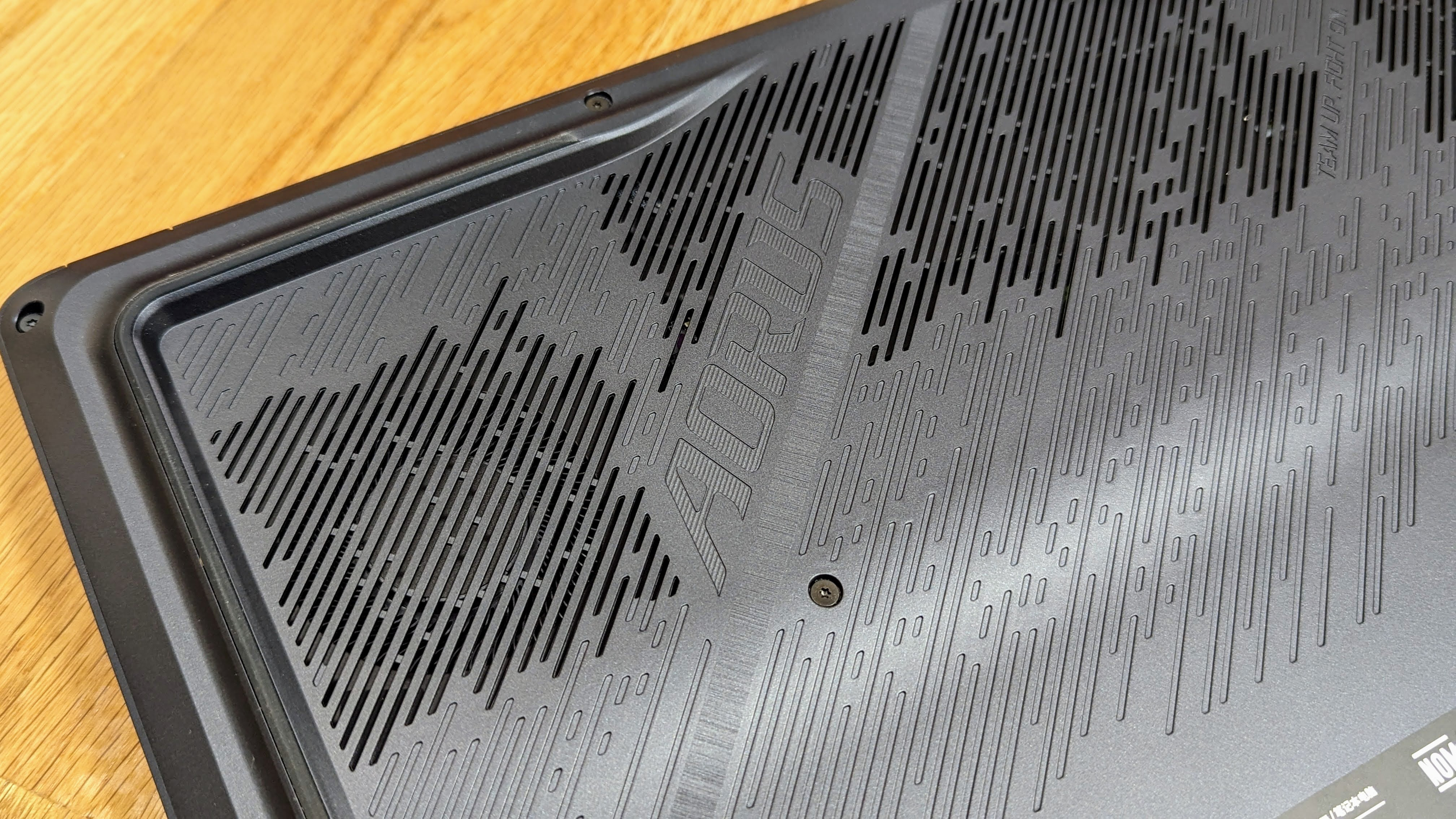
Gigabyte Aorus 16X review: Performance
- Standout single-core CPU performance
- Cooler than average temperatures
- Great frame rates from the RTX 4070 GPU
Here's how the Gigabyte Aorus 16X performed in our suite of benchmark tests:
3DMark: Speed Way: 3,052 Port Royal: 7,846; Time Spy Extreme: 6,473; Fire Strike Ultra: 7,194.
GeekBench 6.2: 2,958 (single-core); 17,567 (multi-core)
Cinebench R24: 1,390 (multi-core); 119 (single-core)
PCMark 10: 8,096
CrystalDiskMark 8 NVMe: 5,147 MB/s (read); 4,800 MB/s (write)
Red Dead Redemption II: (Ultra 1080p) 81 fps
Cyberpunk 2077: 1080p, (Ultra) 71 fps; QHD, (Ultra) 54 fps
F1 2023: 1080p (Ultra): 76 fps
PCMark 10 Battery Life: 8 hours and 3 minutes
1080p video playback battery life: 8 hours and 12 minutes
I’ve tested a wide range of similarly priced laptops that use the RTX 4070 and, generally speaking, for the same GPU thermal design power (TGP) and similar CPU / RAM spec, gaming results don’t vary a huge amount. But subtle differences in how manufacturers configure their CPU and GPU power profiles, as well as other design choices, can lead to consistent differences overall.
For the Aorus 16X, the Gigabyte engineers have done a stellar job optimizing for the settings you will actually game at. While the 16X doesn’t get the best RTX 4070 results in every category, or even the top results overall, it consistently wins on the settings I prefer to game at. Take Cyberpunk 2077 for example. With a 2560 x 1600 screen, I generally like to game at the native resolution and lower ray-tracing quality. On a RTX 4070, this gives around 70fps, or 90fps with DLSS frame generation turned on and a great overall experience. Or, if I want to chase higher frame rates, then starting with a 1080p resolution and low ray-tracing settings, around 95fps is possible and, with a bit of tweaking, 150+ fps with DLSS frame generation turned on. At these settings, the 16X gives the best results out of the RTX 4070 laptops I have tested. Sure, it’s only a few percent above the average, but that’s still a commendable result.
The Aorus 16X also does a great job optimizing its mighty Intel Core i9-14900HX CPU for the sort of usage the laptop will see. As a comparison, the 16X (just) bests the 14900HX-equipped Acer Predator Helios 18 in GeekBench 6 CPU performance. This is despite the Acer running the 14900HX CPU at slightly higher wattage levels, and having a more powerful cooling system.
Impressively, the Aorus 16X also manages these performance gains while being one of the cooler-running gaming laptops I’ve tested. For example, I found the keyboard to be about 20% cooler than the RTX 4070 Lenovo Legion 5i (Gen 9) when gaming and it stays under 30ºC / 86ºF. Overall the temperatures I measured on the 16X are great – 23ºC / 73.4ºF on the trackpad, and 32.1ºC / 89.8ºF on the underside at the hottest spot. Notably though, the 16X is quite loud at full tilt, but is likely to not worry anyone wearing a gaming headset. It’s not great if used in a shared space however.
The Aorus 16X also performs quite well on battery. The laptop cuts CPU power from 100W+ to a max of 55W, but that is still plenty to ensure applications are snappy and performance is reasonable. Battery life is also excellent, but more on that below.
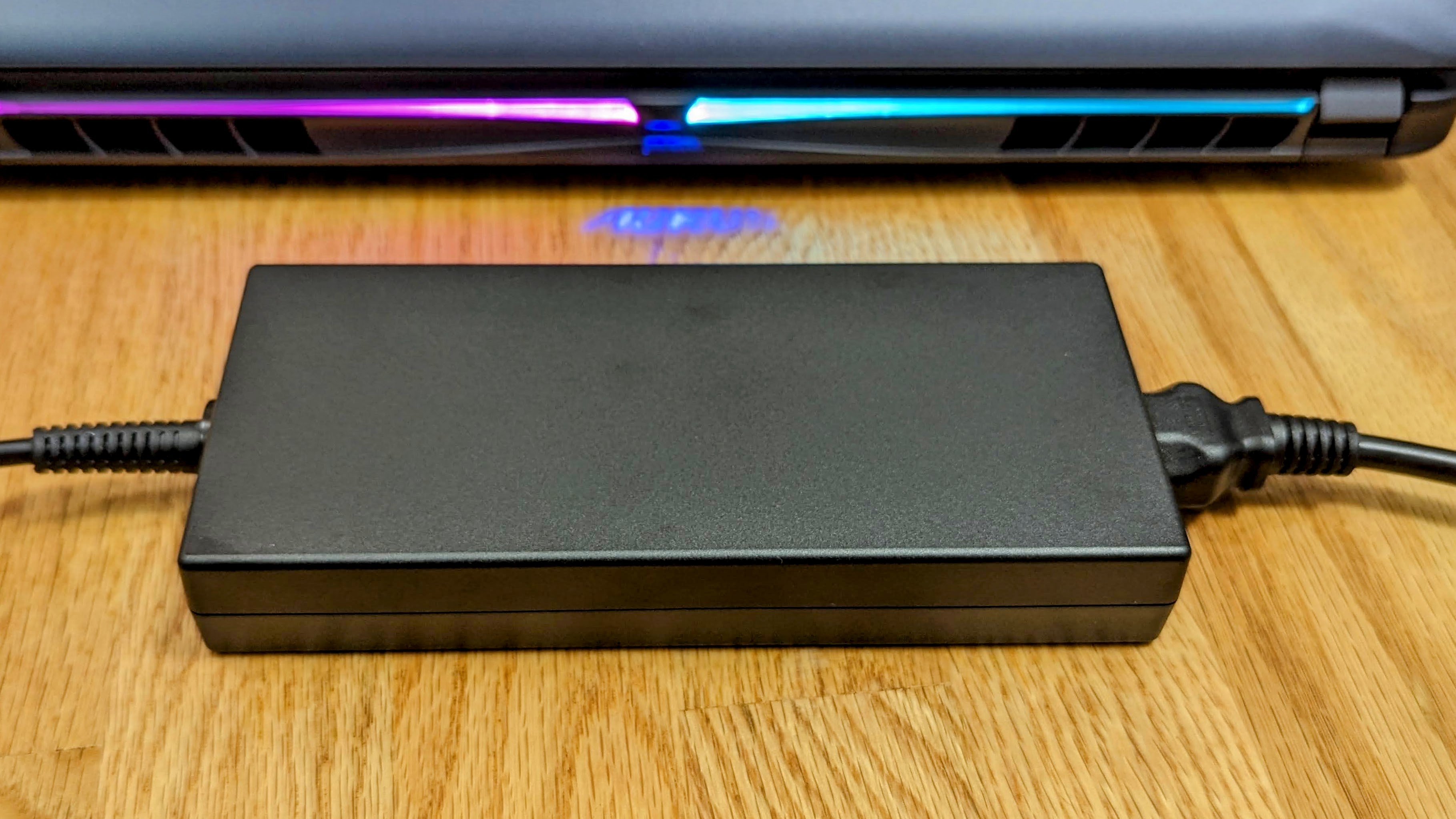
Where the excellent Aorus 16X power profiles expose a flaw is if using the 100W USB-C power option.
The Aorus 16X is advertized as “the ultimate platform for gamers and creators” – and for good reason – gaming machines often make for very powerful workstations. For those wanting to be productive on the go, lugging along a giant power brick is a chore, and USB-C charging (wall charger, dock, or power bank) is much more appealing.
The Aorus stumbles here – when USB-C is plugged in, the laptop restricts maximum performance to very low levels and rarely uses more than 30W out of the 100W available. Even just web browsing can be laggy when using USB-C charging, leaving you relying on the power brick or operating on battery. Gigabyte HQ confirmed this is not a bug – it’s a consequence of the challenges of using USB-C charging on a powerful laptop.
Which begs the question – is this sort of performance loss unavoidable when trying to run power-hungry hardware on limited USB-C power? Or should we expect better?
Yes, we should expect better.
As a comparison, consider the 4070-equipped Alienware m16 R2. It needs a huge power brick for full performance, but like the Aorus 16X it offers 100W USB-C charging. The m16 R2 happily routes all available power from USB-C to the needed hardware and, while (as expected) the performance is much reduced compared to using the power brick, it’s still more than enough for productivity use.
To give some benchmark context to the difference, the Aorus 16X gives a 3DMark Timespy score of 13,608 on AC power, and a mere 605 on USB-C power. The Alienware m16 R2 scores 12,537 on AC, and 4,129 on USB-C – the latter being 6.8 times higher the Aorus 16X USB-C power score.
For gaming-focused buyers, the lack of USB-C performance on the Aorus 16X is not really an issue. The 16X outperforms the Alienware m16 R2 (and many other RTX 4070 laptops) by a noticeable margin, but for anyone who regularly uses USB-C charging or a dock with their laptop, the disappointing experience from the Aorus 16X may be a dealbreaker.
- AC Charger Performance score: 4.5 / 5
- USB-C Performance Score: 2 / 5
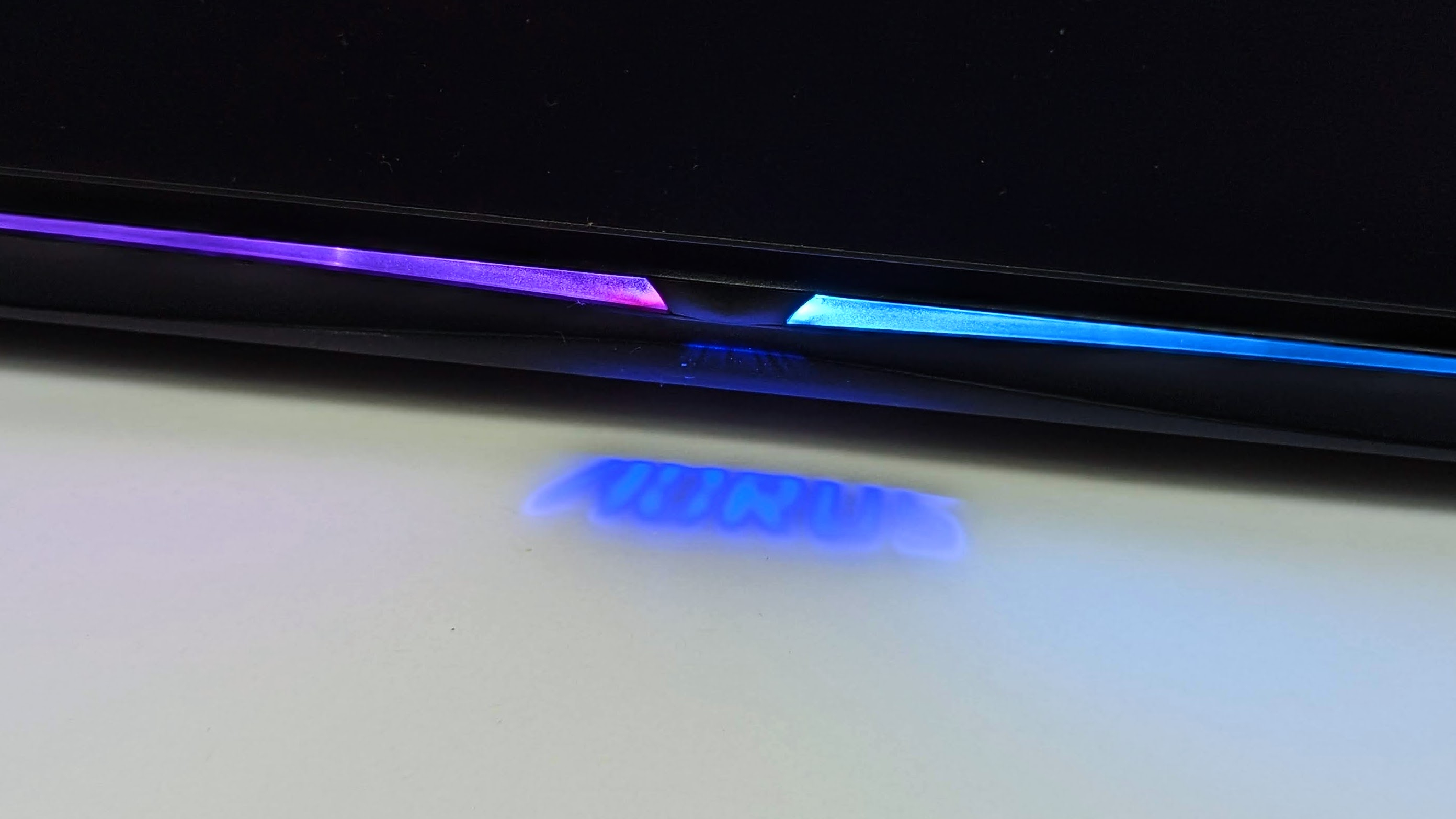
Gigabyte Aorus 16X review: Battery life
- 8 hour 3 minutes work when unplugged
- 8 hours 12 minutes of video playback
While the USB-C power profiles for the Aorus 16X are flawed, the on-battery performance is excellent and enables plenty of time unplugged. Thanks to a large 99Wh battery, the 16X can manage a touch over 8 hours doing basic office productivity tasks or web browsing. Video playback (local or streaming) also gives over 8 hours of use. Gaming battery life is also great, and the 16X can manage 1 hour 47 minutes unplugged – albeit at around 40% lower frame rates compared to when plugged in.
The 16X supports quick charging when plugged into the AC adapter and can bring the battery up to 50% capacity in just 30 minutes. I found that USB-C charging (even with the laptop off) is hit and miss, and it would stop charging for no reason, or charge very slowly. The other issue I experienced was that if the battery is fully drained, you can’t charge using USB-C until first plugging in the AC adapter for a short period.
Gigabyte confirmed that USB-C charging doesn’t work with a dead battery, but has said that with the laptop off, the battery can charge at up to the full 100W on USB-C. I tested this with a wide variety of compatible chargers and cables and 20W (out of 100W) was the most I saw sustained for more than a few minutes.
- Battery life score: 4 / 5
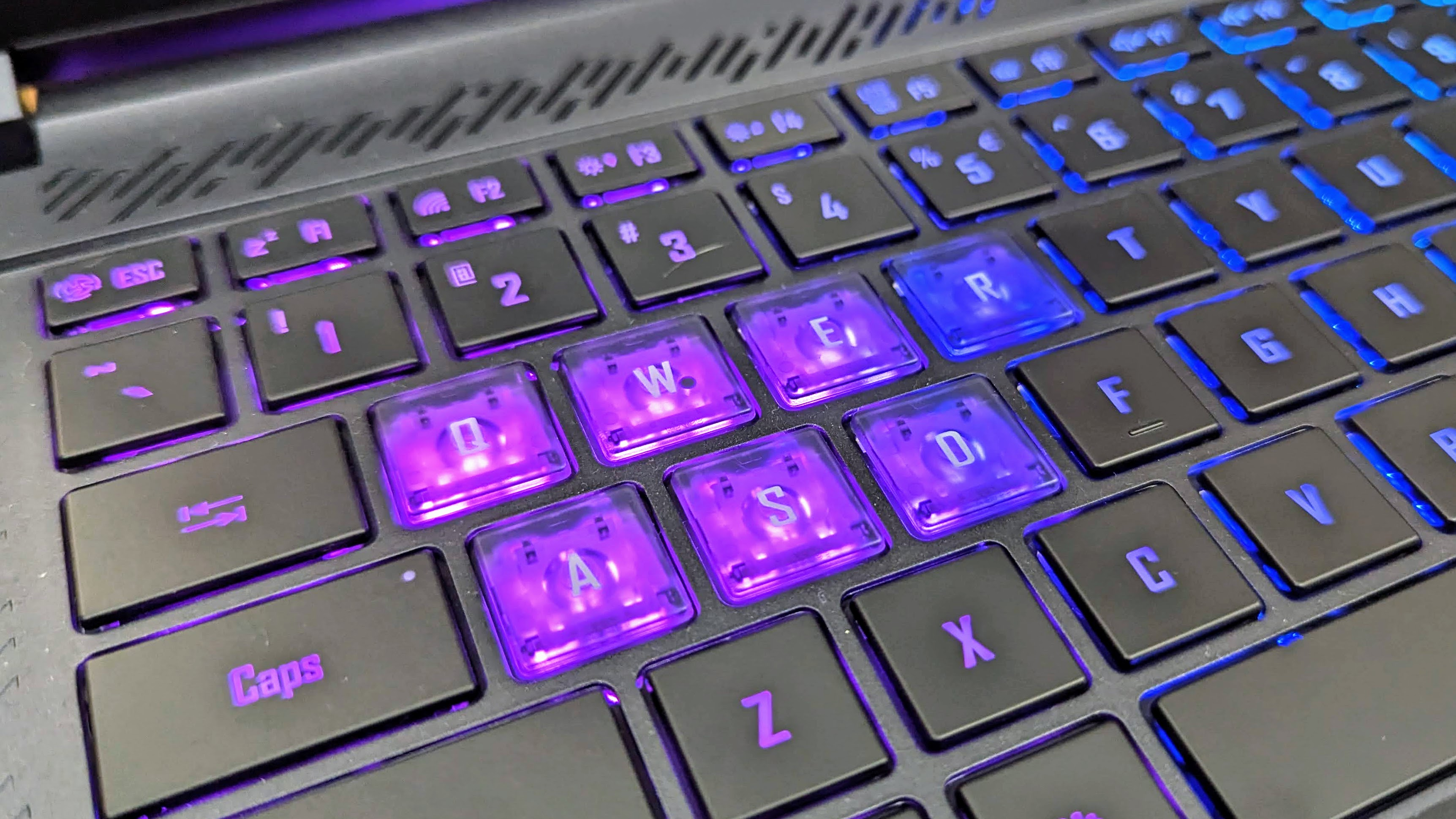
Should you buy the Gigabyte Aorus 16X?
| Attributes | Notes | Rating |
|---|---|---|
| Value | Expensive at list price, but good value when on sale. | 4 / 5 |
| Specs | Great configuration options. | 4 / 5 |
| Design | Well-balanced features and powerful cooling. | 4 / 5 |
| Software and Features | The AI branding hype is excessive, but the Gigabyte software is pretty good. | 3.5 / 5 |
| Performance | Great performance when plugged in, but almost unusable on USB-C. | 3.5 / 5 |
| Battery | Excellent battery life, but limited USB-C charging. | 4 / 5 |
| Overall | An above-average gaming machine, but some serious flaws for productivity or creator use. | 4 / 5 |
Buy it if...
You want excellent gaming performance in a still portable package
The 16X gave class-leading results in many key areas and is very well optimized for gaming at the ideal settings for the hardware.
Your want premium CPU performance
The mighty i9-14900HX CPU combined with the powerful Gigabyte Windforce cooling system gave some of the best CPU performance I have seen.
You want excellent battery life
Eight hours of battery life for everyday use is an excellent result for a gaming laptop – as is almost two hours of actual gaming unplugged.
Don't buy it if...
You value USB-C charging or don’t want to always carry the power brick
The Gigabyte engineers put all the laptop’s character points into gaming performance and almost none into USB-C charging, leaving the latter very limited.
You want a more powerful GPU
The 16X is available with a RTX 4070 or 4060 only. While I love the 4080 and 4090, they are hamstrung in a 16-inch laptop, so I respect the decision from Gigabyte here.
You want quiet gaming at high frame rates
No gaming laptop is quiet when running flat out and the Aorus 16X is no exception. If you want quieter without scaling back performance then consider a larger size, such as the Aorus 17X.
Gigabyte Aorus 16X: Also consider
If our Gigabyte Aorus 16X review has you considering other options, here are some more gaming laptops to consider...
Lenovo Legion 5i (Gen 9) 2024
This mid-range 16-inch gaming laptop is a great option if you are after similar gaming prowess to the Aorus 16X, but better USB-C performance.
Check out our full Lenovo Legion 5i (Gen 9) review
Asus Zephyrus G16
The G16 has the same 16-inch form factor as the Aorus 16X, though is a bit slimmer and lighter if portability is more important than maximum performance.
Check out our full Asus Zephyrus G16 review
Acer Predator Helios 18
Want a bigger screen and more powerful GPU? The Acer Predator Helios 18 is worth a look as it can be decent value when on sale.
Read the full Acer Predator Helios 18 review
HOW I TESTED THE Gigabyte Aorus 16X
- I tested the Gigabyte Aorus 16X for two weeks
- I used it both on a desk, and put it in a backpack for travel
- I used it for gaming, as well as office productivity work and video editing
I ran the Gigabyte Aorus 16X through the usual comprehensive array of TechRadar benchmarks, as well as using it for actual day-to-day work. I tested synthetic gaming and productivity benchmarks, as well as testing with actual games.
I used the TechRadar movie test for assessing battery life during video playback, as well as productivity battery benchmarks. I also logged power use in a variety of scenarios, including when charging from USB-C, and tested the laptop with a variety of USB-C chargers and power banks.
First reviewed June 2024

Lindsay is an Australian tech journalist who loves nothing more than rigorous product testing and benchmarking. He is especially passionate about portable computing, doing deep dives into the USB-C specification or getting hands on with energy storage, from power banks to off grid systems. In his spare time Lindsay is usually found tinkering with an endless array of projects or exploring the many waterways around Sydney.
